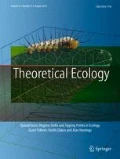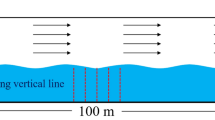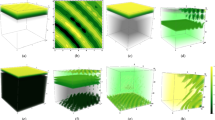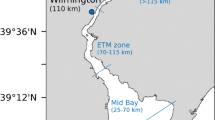Abstract
This study focuses on the role of wind exposure and storm events, in interaction with trophic status and temperature, on the competition between two species: Microcystis aeruginosa and a typical green alga. It is based on a water column model containing ecological and fluid mechanic features including mixing and shear stress at the bottom. This model addresses for the first time the impact of storm events (inducing sediment and nutrient resuspension) on algal dynamics. Simulations with realistic environmental forcings were performed with different sets of wind, temperature, and trophic conditions. With normal temperatures, conditions for dominance and bloom formation of M. aeruginosa in summer are restricted to hypertrophic waters with low wind exposure. Higher wind exposure (above 2 m s−1) impairs the formation blooms even in favorable trophic conditions and enhances the dominance of green algae. Hotter temperatures allow the dominance of M. aeruginosa for lower phosphorus conditions and higher wind exposure and lead to the exclusion of green algae for high phosphorus content and low wind exposure. Nevertheless, high wind exposure (above 3 m s−1) still prevents dense bloom formation and allows the coexistence of both species. Storm events bring two counterbalancing features: sediment and nutrient resuspension. The first leads to a decrease of phytoplankton density in response to high turbidity, and the second leads to an increase and better maintenance of M. aeruginosa blooms due to high phosphorus concentration released in the water. This result depends on the timing of the event and on general wind exposure as phosphorus release only benefits M. aeruginosa if exposure to wind is low.






Similar content being viewed by others
References
Ahmed MS, Hiller S, Luckas B (2008) Microcystis aeruginosa bloom and the occurrence of microcystins (heptapeptides hepatotoxins) from an aquaculture pond in Gazipur, Bangladesh. Turk J Fish Aquat Sci 41:37–41
Baldia SF, Evangelista AD, Aralar EV, Santiago AE (2007) Nitrogen and phosphorus utilization in the cyanobacterium Microcystis aeruginosa isolated from Laguna de Bay, Philippines. J Appl Phycol 19:607–613
Bengtsson L, Hellstrom T (1992) Wind-induced resuspension in a small shallow lake. Hydrobiologia 241:163–172
Bonnet M, Poulin M (2002) Numerical modelling of the planktonic succession in a nutrient-rich reservoir: environmental and physiological factors leading to Microcystis aeruginosa dominance. Ecol Model 156:93–112
Carmichael WW, Azevedo SM, An JS, Molica RJ, Jochimsen EM, Lau S, Rinehart KL, Shaw GR, Eaglesham GK (2001) Human fatalities from cyanobacteria: chemical and biological evidence for cyanotoxins. Env Health Persp 109:663–668
CERC (1984) Shore protection manual, vol 1. US Army Corp of 517 Engineering, Vicksburg
Chao X, Jia Y, Shieldsjr F, Wang S, Cooper C (2008) Three-dimensional numerical modeling of cohesive sediment transport and wind wave impact in a shallow oxbow lake. Adv Water Res 31:1004–1014
Chen Y, Fan C, Teubner K, Dokulil M (2003a) Changes of nutrients and phytoplankton chlorophyll-a in a large shallow lake, Taihu, China: an 8-year investigation. Hydrobiologia 506–509(1–3):273–279
Chen Y, Qin B, Teubner K, Dokulil M (2003b) Long-term dynamics of phytoplankton assemblages: Microcystis-domination in Lake Taihu, a large shallow lake in China. J Plankton Res 25:445–453
Codd GA, Bell SG, Kaya K, Ward CJ, Beattie KA, Metcalf JS (1999) Cyanobacterial toxins, exposure routes and human health. Eur J Phycol 34:405–415
De Figueiredo DR, Azeiteiro UM, Esteves SM, Gonçalves FJM, Pereira MJ (2004) Microcystin-producing blooms: a serious global public health issue. Ecotox Environ Safe 59:151–163
Downing JA, Watson SB, McCauley E (2001) Predicting cyanobacteria dominance in lakes. Can J Fish Aquat Sci 58:1905–1908
Elliott JA, Jones ID, Thackeray SJ (2006) Testing the sensitivity of phytoplankton communities to changes in water temperature and nutrient load, in a temperate lake. Hydrobiologia 559:401–411
Elliott AJ, May L (2008) The sensitivity of phytoplankton in Loch Leven (U.K.) to changes in nutrient load and water temperature. Fresh Biol 53:2–41
Falconer IR, Humpage AR (2005) Health risk assessment of cyanobacterial (blue–green algal) toxins in drinking water. Int J Environ Res Public Health 2:43–50
Gächter R, Müller B (2003) Why the phosphorus retention of lakes does not necessarily depend on the oxygen supply to their sediment surface. Limnol Oceanogr 48:929–933
Graham LE, Wilcox LW (2000) Algae. Prentice Hall, Upper Saddle River
Gumbo RJ, Ross G, Cloete ET (2008) Biological control of Microcystis dominated harmful algal blooms. Afr J Biotechnol 7:4765–4773
Havens KE (2008) Cyanobacteria blooms: effects on aquatic ecosystems. Adv Exp Med Biol 619:733–747
Hellström T (1991) The effect of resuspension on algal production in a shallow lake. Hydrobiologia 213:183–190
Homma T, Komatsu N, Negishi M, Katagami Y, Nakamura K (2008) Influence of dissolved inorganic nitrogen and phosphorus concentrations on the horizontal and temporal changes of Microcystis population in lake. In: Sengupta M, Dalwani R (eds) Proceedings of Taal2007: The 12th World Lake Conference, pp. 1423–1429
Hudnell HK (2010) The state of U.S. freshwater harmful algal blooms assessments, policy and legislation. Toxicon 55:1024–1034
Hudnell HK, Jones C, Labisi LV, Hill DR, Eilers J (2010) Freshwater harmful algal bloom (FHAB) suppression with solar powered circulation (SPC). Harmful Algae 9:208–217
Huisman J, Weissing FJ (1994) Light-limited growth and competition for light in well-mixed aquatic environments: an elementary model. Ecology 75:507–520
Huisman J, Van Oostveen P, Weissing FJ (1999a) Critical depth and critical turbulence: two different mechanisms for the development of phytoplankton blooms. Limnol Oceanogr 44:1781–1787
Huisman J, Van Oostveen P, Weissing FJ (1999b) Species dynamics in phytoplankton blooms: incomplete mixing and competition for light. Am Nat 154:46–68
Huisman J, Sommeijer B (2002) Population dynamics of sinking phytoplankton in light-limited environments: simulation techniques and critical parameters. J Sea Res 48:83–96
Huisman J, Arrayás M, Ebert U, Sommeijer B (2002) How do sinking phytoplankton species manage to persist? Am Nat 159:245–254
Huisman J, Sharples J, Stroom JM, Visser PM, Kardinaal WE, Verspagen JMH, Sommeijer B (2004) Changes in turbulent mixing shift competition for light between phytoplankton species. Ecology 85:2960–2970
Jacoby JM, Collier DC, Welch EB, Hardy FJ, Crayton M (2000) Environmental factors associated with a toxic bloom of Microcystis aeruginosa. Can J Fish Aquat Sci 57:231–240
Jöhnk KD, Huisman J, Sharples J, Sommeijer B, Visser PM, Stroom JM (2008) Summer heatwaves promote blooms of harmful cyanobacteria. Glob Change Biol 14:495–512
Jungo E, Visser PM, Stroom J, Mur LR (2001) Artificial mixing to reduce growth of the blue-green alga Microcystis in Lake Nieuwe Meer, Amsterdam: an evaluation of 7 years of experience. Water Sci Technol 1:17–23
Klausmeier C, Litchman E (2001) Algal games: the vertical distribution of phytoplankton in poorly mixed water columns. Limnol Oceanogr 46:1998–2007
Kosten S, Huszar VLM, Bécares E, Costa LS, Donk E, Hansson L-A, Jeppesen E, Kruk C, Lacerot G, Mazzeo N, Meester L, Moss B, Lürling M, Nõges T, Romo S, Scheffer M (2012) Warmer climates boost cyanobacterial dominance in shallow lakes. Glob Change Biol 12:118–126
Luettich RA, Harleman DR, Somlyody L (1990) Dynamic behavior of suspended sediment concentrations in a shallow lake perturbed by episodic wind events. Limnol Oceanogr 35:1050–1067
Moss B et al (2003) How important is climate? Effects of warming, nutrient addition and fish on phytoplankton in shallow lake microcosms. J Appl Ecol 40:782–792
Mooij WM, Hülsmann S, De Senerpont Domis LN, Nolet BA, Bodelier PLE, Boers PCM, Pires LMD, Gons HJ, Ibelings BW, Noordhuis R, Portielje R, Wolfstein K, Lammens EHRR (2005) The impact of climate change on lakes in the Netherlands: a review. Aquat Ecol 39:381–400
Oberholster PJ, Botha A-M, Grobbelaar JU (2004) Microcystis aeruginosa: source of toxic microcystins in drinking water. Afr J Biotechnol 3:159–168
Ogilvie BG, Mitchell SF (1998) Does sediment resuspension have persistent effects on phytoplankton? Experimental studies in three shallow lakes. Fresh Biol 40:51–63
Ptacnik R, Diehl S, Berger S (2003) Performance of sinking and nonsinking phytoplankton taxa in a gradient of mixing depths. Limnol Oceanogr 48:1903–1912
Paerl HW (1988) Nuisance phytoplankton blooms in coastal, estuarine, and inland waters. Limnol Oceanogr 33:823–847
Paerl HW, Huisman J (2008) Blooms like it hot. Science 320:57–58
Qin B (2004) Dynamics of sediment resuspension and the conceptual schema of nutrient release in the large shallow Lake Taihu, China. Chinese Sci Bull 49:54–64
Reynolds CS (2006) Ecology of freshwater phytoplankton. Cambridge University Press, Cambridge
Rogelj J, Hare W, Lowe J, van Vuuren DP, Riahi K, Matthews B, Hanaoka T, Jiang K, Meinshausen M (2011) Emission pathways consistent with a 2 °C global temperature limit. Nature Clim Change 1:413–418
Singleton VL, Little JC (2006) Designing hypolimnetic aeration and oxygenation systems—a review. Environ Sci Technol 40:7512–7520
Søndergaard M, Jensen JP, Jeppesen E (2003) Role of sediment and internal loading of phosphorus in shallow lakes. Hydrobiologia 506–509:135–145
Soranno P (1997) Factors affecting the timing of surface scum and epilimnetic blooms of blue–green algae in a eutrophic lake. Can J Fish Aquat Sci 54:1965–1975
Scheffer M (1998) Ecology of shallow lakes. Chapman and Hall, London
Sommer U, Adrian R, De Senerpont DL, Elser JJ, Gaedke U, Ibelings B, Jeppesen E, Lürling M, Carlos Molinero J, Mooij WM, van Donk E, Winder M (2012) Beyond the plankton ecology group (PEG) model: mechanisms driving plankton succession. Annu Rev Ecol Evol Syst 43:429–448
Spears BM, Carvalho L, Paterson DM (2007) Phosphorus partitioning in a shallow lake: implications for water quality management. Water Environ J 21:47–53
Teeter AM, Johnson BH, Berger C, Stelling G, Scheffner NW, Garcia MH, Parchure TM (2001) Hydrodynamic and sediment transport modeling with emphasis on shallow-water, vegetated areas (lakes, reservoirs, estuaries and lagoons). Hydrobiologia 444:1–23
Touchette BW, Edwards CT, Alexander J (2008) A comparison of cyanotoxin release following bloom treatment with copper sulfate or sodium carbonate perohydrate. In: Hudnell HK (ed) Cyanobacterial harmful algal blooms: state of the science and research needs, Adv. Exp. Med. Biol. 619, Chapter 14. Springer, New York, pp 314–315
Verspagen JMH, Snelder EOFM, Visser PM, Huisman J, Mur LR, Ibelings BW (2004) Recruitment of benthic Microcystis (Cyanophyceae) to the water column: internal buoyancy changes or resuspension? J Phycol 40:260–270
Verspagen JMH, Visser PM, Huisman J (2006) Aggregation with clay causes sedimentation of the buoyant cyanobacteria Microcystis spp. Aquat Microb Ecol 44:165–174
Visser P, Ibelings B, Van Der Veer B, Koedood J, Mur R (1996) Artificial mixing prevents nuisance blooms of the cyanobacterium Microcystis in Lake Nieuwe Meer, the Netherlands. Fresh Biol 36:435–450
Wiegand C, Pflugmacher S (2005) Ecotoxicological effects of selected cyanobacterial secondary metabolites: a short review. Toxicol Appl Pharmacol 203:201–218
Wu J, Tsanis IK (1995) Numerical study of wind-induced water currents. J Hydrau Eng 121:388–395
Yoshiyama K, Mellard JP, Litchman E, Klausmeier CA (2009) Phytoplankton competition for nutrients and light in a stratified water column. Am Nat 174:190–203
Zegura B, Sedmak B, Filipic M (2003) Microcystin-LR induces oxidative DNA damage in 621 human hepatoma cell line HepG2. Toxicon 41:41–48
Zhu G, Qin B, Guang G (2005) Direct evidence of phosphorus outbreak release from sediment to overlying water in a large shallow lake caused by strong wind wave disturbance. Chinese Sci Bull 50:577–582
Acknowledgments
L.B. thanks G. Hmimina for his help in improving the figures’ quality. We thank the reviewers for their comments which strongly improved the manuscript’s quality. L.B. and this work are financially supported by the ANR Pulse 2010 CEPL 01004. F.M. was supported by a postdoctoral grant from the Université Pierre et Marie Curie (Paris, France).
Author information
Authors and Affiliations
Corresponding author
Appendices
Appendix 1: computation of the bottom shear stress
Wave contribution
The wave contribution τ bw is effective mainly for shallow lakes. It expresses the action of the oscillating boundary layer associated with waves as:
with the friction factor f w :
where A b stands for the maximum wave orbital amplitude and U b stands for the maximum wave orbital velocity. Using the standard wave theory, these quantities A b and U b are given by:
where the wave height H, wave period T, and wave length L are estimated using the following formula (CERC 1984):
where Fetch denotes the fetch length (in meters) of wind.
Current contribution
The contribution for the shear stress due to currents follows from the choice of eddy diffusivity. In a parallel flow approximation with constant pressure gradient, the velocity profile satisfies:
For a steady velocity, this imposes a linear variation of shear with z. The parabolic form of d t , coupled with the constancy of shear and mass conservation for a steady velocity, imposes the following profile:
where the coefficients A, B, and C are functions of z b and z s. This profile leads to the bottom shear stress exerted for the turbulent countercurrent:
in which A 1 is an involved function of the two dimensionless quantities z s and z b.
Appendix 2: phosphorus parameters
Appendix 3
Appendix 4
Percentage of light lost for all depths and dates of Fig. 3
Rights and permissions
About this article
Cite this article
Blottière, L., Rossi, M., Madricardo, F. et al. Modeling the role of wind and warming on Microcystis aeruginosa blooms in shallow lakes with different trophic status. Theor Ecol 7, 35–52 (2014). https://doi.org/10.1007/s12080-013-0196-2
Received:
Accepted:
Published:
Issue Date:
DOI: https://doi.org/10.1007/s12080-013-0196-2






